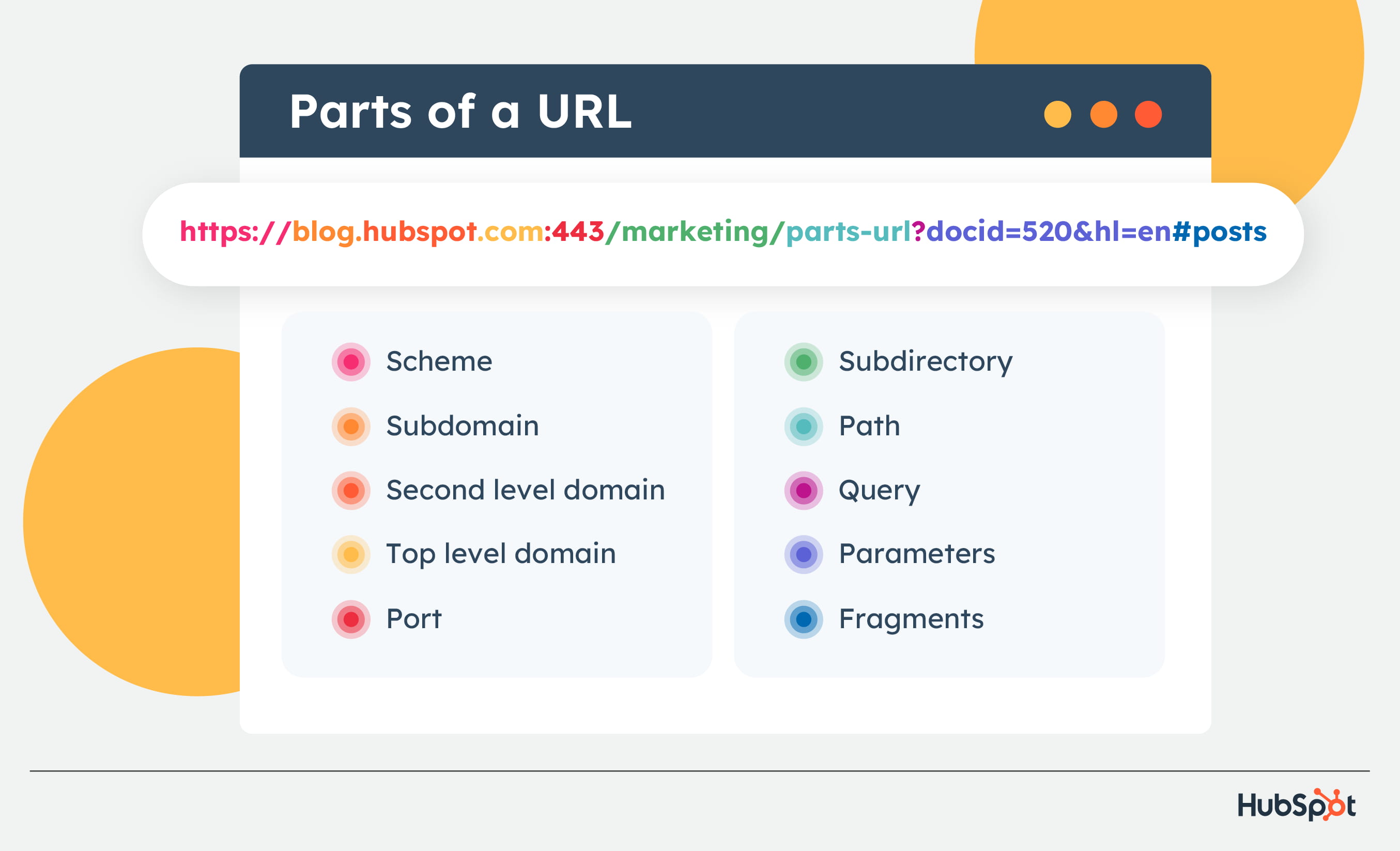[ad_1]
If your web-site is structured like a residence, then your website’s URL is like that house’s address. It defines the place your internet site life on the net, similar to how your dwelling deal with establishes exactly where you dwell in a neighborhood, encouraging your website visitors effortlessly obtain your website. URLs also assist Google comprehend what your website’s webpages are about.
There are several URL elements, and they’re discreetly essential for optimizing your site’s user expertise (UX) and Search engine optimization. To aid you establish a concrete knowing of every aspect of a URL, let us check out each of them in depth.
What are the pieces of a URL?
A URL is made up of ten elements: the plan, subdomain, top-level domain, next-degree domain, subdirectory, parameter, port, path, question, and fragment. Although a URL does not have to contain all of these elements at the moment, it will usually have at minimum three of them.
Under is an illustration of the basic pieces of a URL. A URL will normally have a plan or protocol, a area identify, and path.
.jpg) Nevertheless, URLs may possibly consist of far more characteristics than the basic factors stated above. Let us consider a in depth seem at URL composition beneath.
Nevertheless, URLs may possibly consist of far more characteristics than the basic factors stated above. Let us consider a in depth seem at URL composition beneath.
URL Composition

1. Scheme
 The plan (also termed protocol) tells website servers which protocol to use when it accesses a website page on your website.
The plan (also termed protocol) tells website servers which protocol to use when it accesses a website page on your website.
Nowadays, HTTPS — which stands for Hypertext Transfer Protocol Safe — is the most popular plan. It tells your website browser to encrypt any info you enter on to the website page, like your passwords or credit card facts, so cybercriminals cannot entry it. This stability protocol safeguards your internet site readers and employing it will aid your site rank better on Google. Which is why applying SSL is a should-do on any specialized Website positioning guide.
Other techniques you may possibly see are mailto://, which can open up your computer’s default email services company to assist you draft an e mail to the e-mail address you entered in the URL, and ftp://, which is a regular protocol for transferring laptop or computer files between a client and server on a computer network.
2. Subdomain
 If your web-site is like a home, your subdomains are like particular rooms in that residence. A subdomain in a URL indicates which distinct page of your site the internet browser should provide up. For occasion, subdomains like “blog” or “offers” will present your website’s blog page or provides web page.
If your web-site is like a home, your subdomains are like particular rooms in that residence. A subdomain in a URL indicates which distinct page of your site the internet browser should provide up. For occasion, subdomains like “blog” or “offers” will present your website’s blog page or provides web page.
Subdomains also bucket your website into its principal content groups and displays Google and your website visitors that there’s much more information and facts on your internet site than just a homepage.
3. 2nd-stage Area
 Your next-degree domain (SLD) is the name of your internet site. It can help men and women know they are viewing a specific brand’s website. For occasion, folks who take a look at “mlb.com” know they’re on Main League Baseball’s site, without having needing any more info.
Your next-degree domain (SLD) is the name of your internet site. It can help men and women know they are viewing a specific brand’s website. For occasion, folks who take a look at “mlb.com” know they’re on Main League Baseball’s site, without having needing any more info.
4. Major-level Domain
 The top-degree domain (TLD) specifies what form of entity your corporation registers as on the internet.
The top-degree domain (TLD) specifies what form of entity your corporation registers as on the internet.
For case in point, “.com” is meant for business entities in the United States, so a large amount of American corporations register with a leading-amount area of “.com”. Similarly “.edu” is supposed for educational establishments in the United States, so a large amount of American colleges and universities sign up with a best-degree domain of “.edu”.
5. Subdirectory
 A subdirectory — also recognised as a subfolder — helps people as properly as world-wide-web crawlers have an understanding of which particular section of a webpage they’re on.
A subdirectory — also recognised as a subfolder — helps people as properly as world-wide-web crawlers have an understanding of which particular section of a webpage they’re on.
For occasion, if you have an on the net retail outlet that sells t-shirts, hats, and mugs, just one of your website’s URLs could seem like “https://shop.yourstore.com/hats”. Recognize that the subdomain is “shop” and the subdirectory is “hats.” That implies this URL would serve up the “Hats” website page, which is a subfolder of the “Shop” webpage. T-shirts and mugs would be other subfolders of this page.
6. Port
The port is a quantity utilized to specify a link endpoint and to immediate details to a particular company. Different servers will use diverse port numbers. This number is normally connected with a host network address, like an IP deal with. For case in point an HTTP server is determined making use of 80, even though an HTTPS server takes advantage of 443 as its port selection.

7. Path
The route specifies the locale of the file or useful resource that the person desires to obtain. In the example below, the specified path would be the write-up “parth-url.”

8. Question
Ever recognized a query mark shown in some URLs when Google displays your lookup outcomes? That dilemma mark says that a certain query is staying carried out and is utilised to precede a question string. A question string specifies the parameters of the knowledge becoming requested from a website’s databases. We’ll dig into parameters upcoming.

9. Parameters
Parameters are the values becoming queried throughout a lookup. The parameter can be a number, encrypted worth, lookup term or other information that can be located on the internet site. URL parameters consist of a vital and benefit, separated by an equal indicator (=). A URL can include multiple parameters, which are then every separated with an ampersand (&).
Written out, the construction would glance like this:
https//www.hubspotexample.com/webpage?essential1=worth1&crucial2=value2

UTM parameters are applied to observe your promoting or advertising initiatives. Included to the ends of URLs these parameters can monitor how people are coming to your web site and if they’re interacting with an linked advertising campaign.
10. Fragments
Fragments are an optional part of URLs that are ordinarily put at the finish with a hash (#). They indicate a unique locale on the webpage like an ID or identify attribute, but can also immediate to other methods like a footer, or sidebar.

URL Framework: Delicate But Necessary
Even although URLs could possibly seem simple and arbitrary, they’re actually critical for your website’s UX and Search engine optimisation. And now that you fully grasp each of the URL sections, verify out the website posts below to learn far more about technical Search engine optimisation.
Editor’s observe: This write-up was originally printed in Oct 2021 and has been updated for comprehensiveness.
[ad_2]
Supply website link











